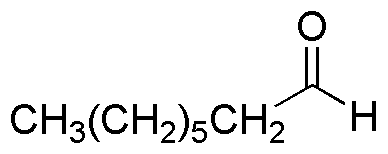Octanal is widely utilized in research focused on:
- Flavor and Fragrance Industry: Octanal is a key ingredient in creating citrus and fruity flavors in food products and fragrances, enhancing sensory appeal.
- Chemical Synthesis: It serves as an important intermediate in the synthesis of various organic compounds, including alcohols and acids, facilitating the development of new materials.
- Biochemical Research: Octanal is used in studies related to lipid metabolism and cellular signaling, providing insights into biological processes and potential therapeutic targets.
- Cosmetic Formulations: Its pleasant scent and emulsifying properties make it a popular choice in cosmetic products, improving texture and user experience.
- Agricultural Applications: Octanal can act as a natural insect repellent, contributing to eco-friendly pest control solutions in agriculture.
General Information
Properties
Safety and Regulations
Applications
Octanal is widely utilized in research focused on:
- Flavor and Fragrance Industry: Octanal is a key ingredient in creating citrus and fruity flavors in food products and fragrances, enhancing sensory appeal.
- Chemical Synthesis: It serves as an important intermediate in the synthesis of various organic compounds, including alcohols and acids, facilitating the development of new materials.
- Biochemical Research: Octanal is used in studies related to lipid metabolism and cellular signaling, providing insights into biological processes and potential therapeutic targets.
- Cosmetic Formulations: Its pleasant scent and emulsifying properties make it a popular choice in cosmetic products, improving texture and user experience.
- Agricultural Applications: Octanal can act as a natural insect repellent, contributing to eco-friendly pest control solutions in agriculture.
Documents
Safety Data Sheets (SDS)
The SDS provides comprehensive safety information on handling, storage, and disposal of the product.
Product Specification (PS)
The PS provides a comprehensive breakdown of the product’s properties, including chemical composition, physical state, purity, and storage requirements. It also details acceptable quality ranges and the product's intended applications.
Certificates of Analysis (COA)
Search for Certificates of Analysis (COA) by entering the products Lot Number. Lot and Batch Numbers can be found on a product’s label following the words ‘Lot’ or ‘Batch’.
*Catalog Number
*Lot Number
Certificates Of Origin (COO)
This COO confirms the country where the product was manufactured, and also details the materials and components used in it and whether it is derived from natural, synthetic, or other specific sources. This certificate may be required for customs, trade, and regulatory compliance.
*Catalog Number
*Lot Number
Safety Data Sheets (SDS)
The SDS provides comprehensive safety information on handling, storage, and disposal of the product.
DownloadProduct Specification (PS)
The PS provides a comprehensive breakdown of the product’s properties, including chemical composition, physical state, purity, and storage requirements. It also details acceptable quality ranges and the product's intended applications.
DownloadCertificates of Analysis (COA)
Search for Certificates of Analysis (COA) by entering the products Lot Number. Lot and Batch Numbers can be found on a product’s label following the words ‘Lot’ or ‘Batch’.
*Catalog Number
*Lot Number
Certificates Of Origin (COO)
This COO confirms the country where the product was manufactured, and also details the materials and components used in it and whether it is derived from natural, synthetic, or other specific sources. This certificate may be required for customs, trade, and regulatory compliance.

